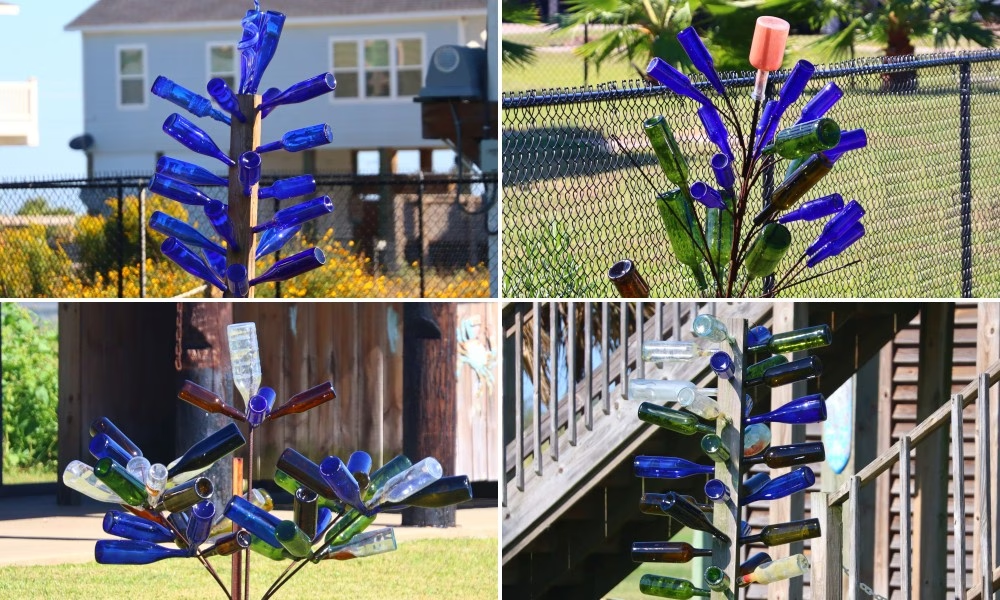
The bottle tree, a captivating piece of folk art found prominently in the American South, is far more than just a colorful garden ornament. This tradition carries centuries of spiritual significance and cultural history, tracing its roots back to ancient practices in Africa.
History and Origin
The tradition of hanging glass vessels in trees to ward off malevolent spirits is an ancient one with multiple threads:
- Ancient Origins: The belief that spirits could inhabit glass bottles may date back as far as 1600 B.C. in Egypt and Mesopotamia. Tales circulated that the sound of wind over bottle openings was the sound of trapped spirits, a folklore that eventually spread.
- African Roots: The practice became a distinct tradition in West Africa, particularly in the Kongo region, dating to at least the ninth century. Here, bottles and other glass objects were used as talismans to capture spirits and were sometimes part of funerary rituals to protect the dead person’s essence.
- Arrival in the Americas: The custom was brought to the Americas by enslaved Africans during the transatlantic slave trade, taking root in the Caribbean and becoming a particularly prominent part of the African American and Hoodoo folk tradition in the Southern United States (from East Texas to South Carolina). Early accounts of the practice in the US date back to the 17th and 18th centuries.
Traditionally, the bottles were placed upside down on the branches of a crape myrtle or cedar tree—the crape myrtle often symbolized escape and freedom for the enslaved. The bottles would lure and trap nocturnal spirits with their shimmering surfaces; the trapped spirits would then be destroyed by the morning sunlight.
Spiritual and Cultural Significance
The bottle tree is rich with meaning, particularly within the context of Hoodoo and African American culture:
- Protection: The primary purpose was and often remains protection of the home and family from evil spirits, bad luck, and thieves. The whistling sound of wind blowing over the bottle necks is traditionally believed to be the moaning or howling of the trapped spirits.
- The Power of Blue: Cobalt blue bottles are the most traditional and highly favored color. Blue is associated with spirits and ghosts, and in the Hoodoo tradition, it is believed to have mystical properties, sometimes linked to water (which evil spirits supposedly hate) and the color of the sky, connecting the tree to the ancestors. Milk of magnesia bottles, historically available in cobalt blue, were often repurposed for this.
- Honoring the Dead: The tradition also connects to ancestral veneration. Some practices used the blue bottles to capture the energy, spirit, and memories of ancestors. Bottles have also been used in African American graveyards to decorate the grave and keep the deceased person’s talents from escaping.
Modern Popularity
While the belief in the bottle tree as a protective talisman has waned for many, the tradition has enjoyed a resurgence in popularity as an expressive form of folk art and garden decoration:
- Folk Art and Aesthetics: Today, bottle trees are widely appreciated for their whimsical, colorful appeal, with the sun turning the glass into a “poor man’s stained glass.” They add a unique focal point to gardens across the country, especially in the South.
- Adaptation: While traditionalists use dead tree branches, modern versions are often metal armatures constructed from rebar, copper pipe, or a wooden post with metal rods, making them durable and easy to install.
- Upcycling and Sustainability: The bottle tree also appeals to modern sensibilities as a form of upcycling and repurposing discarded glass bottles, promoting sustainability while creating art.
- Cultural Legacy: The enduring image of the bottle tree has been cemented in Southern culture, notably appearing in the photography and literature of figures like Mississippi author Eudora Welty, whose 1943 short story “Livvie” featured the iconic object.
As the tradition evolves, the bottle tree serves as a vibrant reminder of its deep cultural legacy, connecting ancient African spiritual practices with the distinctive folk art of the American South.




